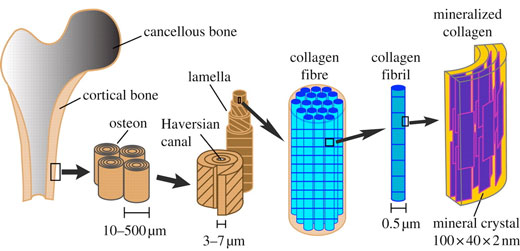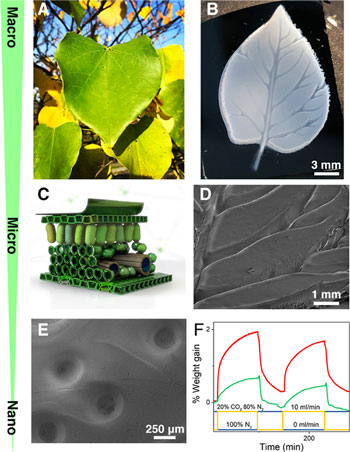| Oct 22, 2019 | |
Fabricating nano- to macroscale hierarchical porous structures in a 3D printer |
|
| (Nanowerk Spotlight) Hierarchical structures, spanning multiple length scales from nano- to macroscales, are very common in nature; but only in recent years have they been systematically studied in materials science, in order to understand the specific effects they can have on the mechanical properties of various systems. | |
| Bone, for example, combines soft organic collagen material and hard crystal phases in an organized multi-level structure: | |
 |
|
| Hierarchical structure of bone. (Reprinted with permission by Royal Society of Chemistry from DOI: 10.1098/rspb.2010.1093) | |
| This structural hierarchy in materials can play a major part in determining the bulk material properties. | |
| "The ability of natural systems to spontaneously self-assemble into complex, hierarchical, multifunctional structures provides an intriguing inspiration to create biomimetic hierarchical structures," Jen-Yu Huang, a PhD Candidate at Cornell University's Robert Fredrick Smith School of Chemical and Biomolecular Engineering, tells Nanowerk. "Analogous hierarchical assembly strategies in synthetic systems (e.g., metal-organic frameworks) have intrigued scientists and engineers for years. However, our ability to fabricate porous three-dimensional structures with programmable geometries from these building blocks is still in its infancy compared to the complexity found in natural systems." | |
| Huang is first author of a paper in Chemistry of Materials ("Three-Dimensional Printing of Hierarchical Porous Architectures") where a team of scientists from Cornell University present a straightforward, cost-efficient, and fast route to fabricate hierarchical porous structures in a 3D printer. | |
| Specifically, they demonstrated the fabrication of a leaf inspired by similarly complex three-dimensional (3D) hierarchical mesoporous structures ubiquitous in nature. | |
| "This result demonstrates our ability to process nanoporous materials and fabricate structures from nanometer to centimeter scale," Huang notes. "Our design is based on attaching a photoresponsive ligand to the surface of an inorganic core (PLIC). The inorganic core and organic ligand fused on the molecular scale generate a synergetic combination of innate properties from each component." | |
| In their experiments, the team functionalized the surface of oxozirconium clusters with methacrylate groups. The photoresponsive methacrylic acid ligands serve two functions: to provide colloidal stability and as a molecular connector by photopolymerizing the carbon double bond. | |
| Using PLIC as the nanoparticle building units in printing inks, the team fabricated 3D objects via digital light processing (DLP), a photoresin-based additive manufacturing technique. | |
 |
|
| 3D printing photoresponsive ligand on inorganic core (PLIC) assembly. Schematic representation of multilevel control in the printing process. PLIC materials are used as the building units and structured by a series of two-dimensional UV images in the 3D printer. (Reprinted with permission by American Chemical Society) (click on image to enlarge) | |
| "To underscore the practical utility of the mesoporous structures that can be fabricated using our method, we demonstrated the proof-of-concept 3D printing of a highly porous leaf," says Huang. "This choice of model structure was inspired by natural leaves, in which the hierarchical porous structure has been refined through billion years of evolution to endow all levels of hierarchy from macropores for fluid and nutrient transportation, micropores for gas diffusion, and nanopores for gas adsorption to perform complicated and optimal transport, and optical and chemical functionalities." | |
 |
|
| Complex devices like a leaf can be fabricated with 3D printing PLIC. (A) Photographic image of a leaf. (B) Photographic image of an artificial leaf. (C) Three-dimensional illustration of a leaf structure from a cross-sectional view. (D) SEM image of channels mimicking veins. (E) SEM image of small pores like stomata on the back surface. (F) CO2 capturing capacity of 3D-printed artificial leaf. Red line: modified sample with amine group; green line: unmodified printed sample. (Reprinted with permission by American Chemical Society) | |
| Nanoporous materials are very fragile and often difficult to process, and as a result they are mostly available in powder form. The Cornell team solved this issue and demonstrated that with their 3D-printing technique even porous leaf-like structures can be achieved. | |
| Huang points out that the principle of PLIC design is applicable to different cores and ligands, which can be seen as a promising bottom-up avenue for nanomaterial fabrication. Already, the team is not only printing materials with nanoscale pores, they are now working on printing semiconductor materials as well. | |
| The intersection of inorganic building blocks and 3D digital light processing opens new pathways to create functional hierarchical superstructures and devices with complex geometries. This work potentially benefits applications in separation, sensing, catalysis, bio-scaffold, energy storage and many more. | |
 By
Michael
Berger
– Michael is author of three books by the Royal Society of Chemistry:
Nano-Society: Pushing the Boundaries of Technology,
Nanotechnology: The Future is Tiny, and
Nanoengineering: The Skills and Tools Making Technology Invisible
Copyright ©
Nanowerk LLC
By
Michael
Berger
– Michael is author of three books by the Royal Society of Chemistry:
Nano-Society: Pushing the Boundaries of Technology,
Nanotechnology: The Future is Tiny, and
Nanoengineering: The Skills and Tools Making Technology Invisible
Copyright ©
Nanowerk LLC
|
|
|
Become a Spotlight guest author! Join our large and growing group of guest contributors. Have you just published a scientific paper or have other exciting developments to share with the nanotechnology community? Here is how to publish on nanowerk.com. |
|
